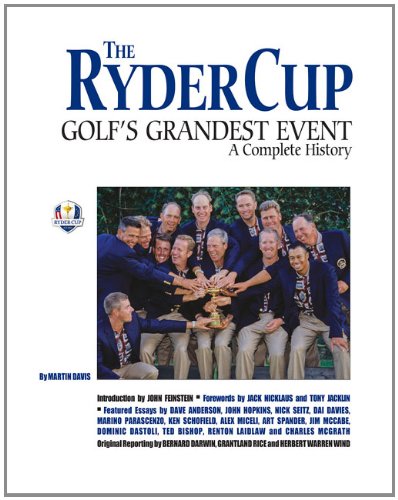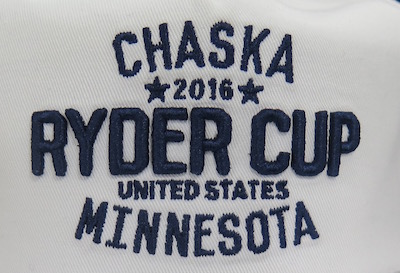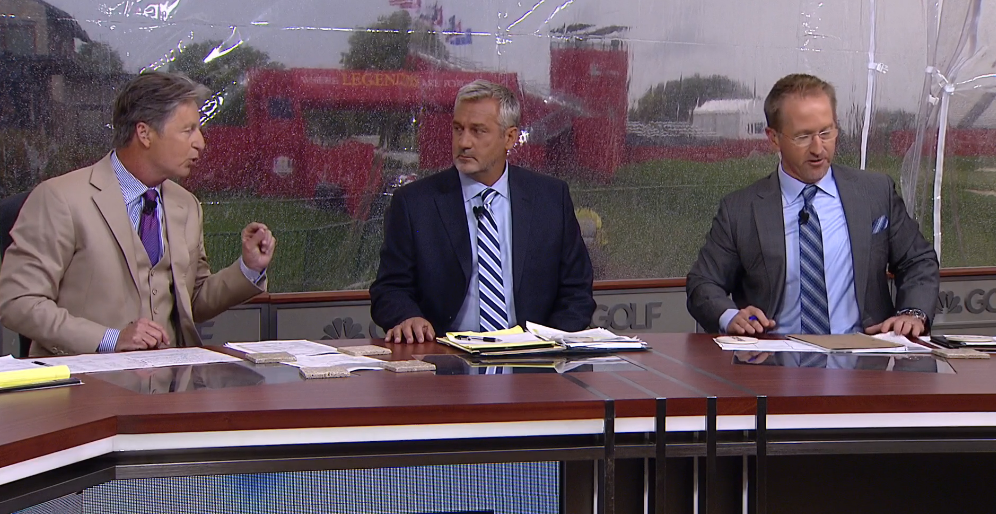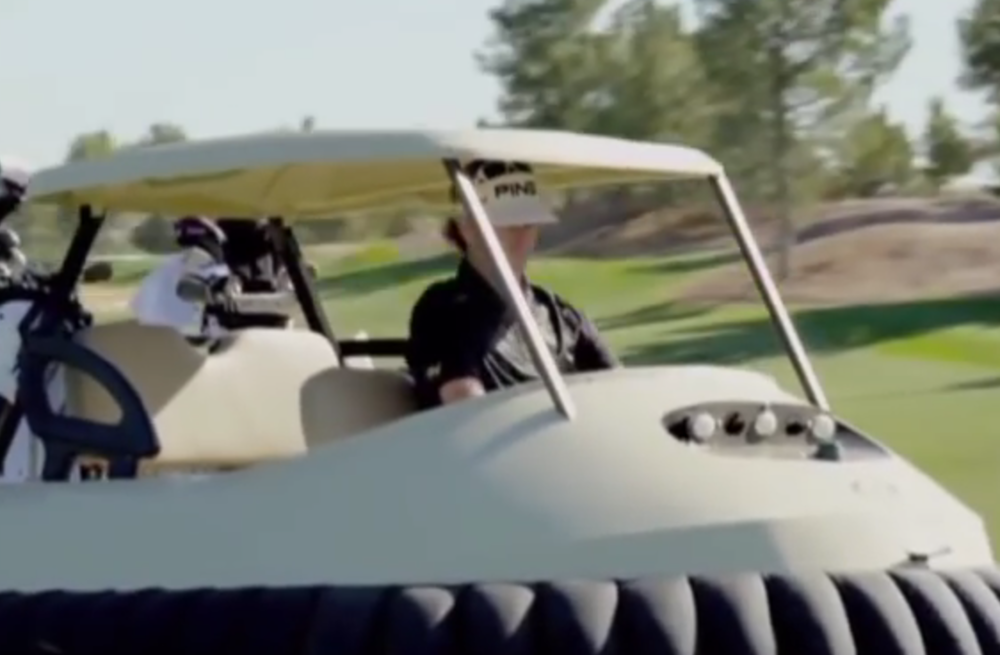Few volumes seeking to capture the history of a significant golf tournament or course will ever match the The Ryder Cup: Golf's Grandest Event. Publisher and writer Martin Davis has put together the usual list of elite names that have contributed to previous efforts, and combines their words with an incredible array of photos, facts and records documenting what has become golf's most dramatic event.
You can check out the book here at Amazon, and if you're on site at Hazeltine this week the book is available in the merchandise tent.
Davis kindly answered questions on his latest coffee table epic and the Ryder Cup.
GS: Let’s get to the breaking news first: the book reveals the Ryder Cup started in 1927 and that is not Abe Mitchell atop the trophy. Reveal your sources. Tell all!
MD: Contrary to published reports and in the media guides from the European Tour and the PGA of America for many years claiming the first Ryder Cup first took place in 1927, the first Ryder Cup was actually contested in 1926 at Wentworth in southern England.
The story that had been put out for many years held that Sam Ryder was sitting in the Wentworth Clubhouse celebrating with the British pros a win over an American Team captained by Walter Hagen - eating chicken sandwiches and drinking champagne, it was reported - when Ryder reportedly said, "this was great, we must do it again, I'll even donate a trophy."
 It's a nice story, but it's simply not true.
It's a nice story, but it's simply not true.
In our research, we found that Ryder announced in late 1925 that the inaugural Ryder Cup would take place at Wentworth in early June of 1926. It was reported in several of the biggest, most well-respected newspapers in England.
At first it was referred to as the "Ryder" Trophy. Later as The Ryder Cup.
And the event itself was reported in nine of the major media outlets of the day, all telling the same story of the event before, during and after the Matches that June at Wentworth, referring to the event as The Ryder Cup in headlines and body copy.
So who were these sources?
None other than the most significant newspapers, wire services and golf magazines of the day.
The Daily Telegraph, The Times (London), The Sunday Times, The New York Times, The New York Herald Tribune, Golfing Magazine and Golf Illustrated Magazine (UK) and finally the wire services - the Associated Press and Reuters - who sent the stories around the world for publication in numerous newspapers.
(And if there is any doubt as to veracity of the reports, it was Bernard Darwin, golf's first truly great golf writer, considered the gold standard, who provided the reports for The Times and The Sunday Times.)
And the actual articles from the various publications reporting on the Ryder Cup are reprinted in the book.
There's no question that this was intended to be the first Ryder Cup and was reported contemporaneously with the event as such. Indeed this was the first Ryder Cup.
And our research also found that the trophy was manufactured and assayed (certifying as to the gold content, who made it, etc.) in April of 1926. So the Cup was ready in time for the event at Wentworth.
GS: So what happened?
MD: It's a fascinating story.
In the spring of 1926 some 800,000 English coal miners went on strike for higher wages and better working conditions. In sympathy, the other major unions in the UK - including all of the transportation workers - joined the miners. It was referred to as The General Strike. It effectively shut down the entire country.
Playing captain Walter Hagen and four other members of the first American Team had already made it into England before the strike. (Ryder had asked Hagen to form a team to play for the Cup in late 1925.) But other original members of the Team - including such big-name players as Sarazen, Farrell, Diegel and MacFarlane - couldn't get into the country. So Hagen asked five expats that were living in the US and had made it into England to try to qualify for the Open Championship to fill out the American side. The five included two Brits, two Scots (one was Tommy Armour, the famed Silver Scot) and an Australian trick shot artist (Joe Kirkwood). The "Americans" got waxed, 13 1/2 to 1 1/2, losing to captain Ted Ray's British Team.
Realizing that the Americans didn't have a properly constituted team, Ryder decided to withhold the trophy until the next year where it would be played at Worcester CC in Massachusetts.
So the first Ryder Cup was actually played at Wentworth in 1926, but the first "official" Ryder Cup was played in America in 1927. When the Cup was awarded for the first time.
The story about the now iconic diminutive 17 1/2 inch high solid gold trophy is similarly one that took a life of its own.
For years the narrative was that Sam Ryder, in ordering the trophy from jewler Mappin and Webb, had the figure crafted on top in the image of his good friend and golf teacher Abe Mitchell. It was a romantic story of friendship and loyalty.
In researching the origins of the Cup, we went to England and tried to find the origins of the Cup. We hired the world's expert on the Ryder Cup (and other sporting trophies), John Bowles, to track down some of the new facts we uncovered. In doing so, he found that the trophy was not a custom made one ordered by Ryder, but one that had been in the Mappin and Webb's catalog for a number of years, thus dashing the romantic feel-good story. In addition, we uncovered five or six additional facts that clearly showed that this wasn't Abe Mitchell on top of the Ryder Cup, but there sure was a striking resemblance. But you'll have to get the book to glean what we uncovered.
GS: The cup itself has been making the rounds, even in the country that does not currently hold it. Give us a little more reason to adore this small gold trophy?
MD: Why adore Sam Ryder's diminutive little trophy?
Because it's clearly the most fun event in golf.
It puts all of our heroes on a team that we can root for as a group. Hey, they're representing us. And those guys in the black hats, those Europeans, they're representing the bad guys. It's us against them. And the little trophy, which we used to win ALL THE TIME, has been won by the bad guys eight out of the last ten times. Hey, we want OUR trophy back.
Here's a story in the book. It will give you the "us against them flavor."
The 1947 Ryder Cup, the first after World War II, was held at Portland Golf Club. Ben Hogan was the playing captain for the U.S., Henry Cotton, multiple winner of the Open Championship, captain for the Brits.
On the eve of the Ryder Cup, Cotton goes to the officials and claims the Americans are playing with illegal clubs (I think he saw Hogan hit the ball for the first time and couldn't believe the spin he got on it,) and he wants the American's clubs inspected. So the officials do so and find that all of the American's clubs conform to the rules.
Fast forward to the next Ryder Cup, 1949 at Ganton in England. Hogan is captain again, but the non playing captain because of the horrific accident that almost took his life earlier in the year. So on the eve of the Ryder Cup, Hogan, remembering what Cotton had done to his team two years earlier, asked that the Brit's clubs be inspected.
And guess what? They found that the edges on two of the British players clubs were too sharp and thus nonconforming. So the host pro spent most of the night filing the edges down! I guess turnabout is fair play. Hogan thought so about the guys in the black hats.
GS: The book is truly a breathtaking undertaking, how many years was this in the works and what inspired you to attack what is such a massive undertaking?
MD: It really was a massive undertaking - I worked on it for 6 1/2 years. Once it got started, it took on a life of its own, as it ended up at 500 pages with 7-800 photos, three double gatefold spreads and one gate - a Ryder Cup timeline - that folds out to almost six feet, in a jumbo 11 X 14 coffee table size. Heck it weighs in at almost nine pounds! The joke is, if you get tired of reading it, you can always work out with it.
As you know, I'm very concerned with quality. As such, we print all our big books in Italy at one of the finest art book printers in the world.
Thankfully I own the company, so I could keep stretching what passed as a budget. My accountant is not very happy at all, but I felt it was something that just had to be done.
It was maybe the hardest thing I've ever done, but it is certainly the most rewarding when I look at the finished product and see people's reactions.
GS: Many disagree on the year the Ryder Cup went to a different stratosphere both in the early days and the modern era. Which cups defined what the matches became both in the good old days and in more recent times?
MD: Right from the beginning, the Ryder Cup was a big idea. All the Cups before the War had good attendance and a lot of interest by the media. But in the 60s and 70s interest waned as the American side simply dominated - we'd show up in our fancy blazers, play a practice round or two, go to a big dinner, win convincingly and take Sam Ryder's little cup home. (Somehow we lost in 1957 at Lindrick - we're still trying to figure out what happened.)
But after Jack Nicklaus suggested to Lord Darby that Europe be included (and that meant the best player in the world at the time, Seve), interest started to pick up. But the watershed event was 1987 when the U.S. lost for the first time on home soil as Captain Tony Jacklin's Euro squad beat Captain Jack Nicklaus at Jack's course Muirfield Village, with Woosie and Sandy Lyle, a rookie named Faldo and Seve and Sam Torrance. And to add insult to injury, it was in Jack's home town of Columbus, Ohio.
It seemed that the more the Euros beat the U.S., the bigger the Ryder Cup became.
To me, the Matches that defined the Cup are fairly recent. Captain Ben Crenshaw's furious comeback in 1999 at The Country Club and then Captain Jose Maria Olazabal's equally strong comeback to win at Medinah in 2012. Both of those were fiercely fought, passionate and golf at its very highest level.
GS: As much research and reading as you’ve done, and having taken in where we are now with almost as many Vice Captains as players, the profiteering, the lousy courses played in Europe in the name of cash, is this a healthy place from where Samuel Ryder started things?
MD: You're really correct about the profiteering and lousy courses for a while.
But we're at a great spot now. We're going to France for the next Cup at a course just outside of Versailles (Let me be the first to say, "Let them eat cake." Sorry, I couldn't resist.) at what should be a wonderful venue. Next up for us is Whistling Straights and then my favorite Tillinghast course of all, Bethpage Black. (If you think it's going to be a little raucous at Hazeltine, wait until we get to Long Island for the Cup!)
GS: Best and worst courses to host the Ryder Cup?
MD: Best - Muirfield in Scotland
Worst - The Belfry, perhaps Thunderbird and Eldorado in Palm Springs in 1955 and 1959
GS: Best captaining job, USA edition? (Win or lose).
MD: U.S. - Walter Hagen in 1927, 1929, 1931, 1933, 1935, 1937 and don't forget 1926 and the two teams he was named to captain during World War II that only played exhibition matches in the States. The Haig could have been captain for life. (I'd give a close second to Ben Crenshaw or 1999.)
GS: Best captaining job, UK/Europe edition? (Win or lose).
MD: Europe - Without question, Tony Jacklin who brought Europe back and set the standard for them. (A close second to Jose Maria Olazabal and also to Paul McGinley for the incredible organizational and motivational job he did at Gleneagles in 2014.)
GS: Your book reminds us that the Cup has been to some strange and amazing courses, but lately we’re sort of stuck in Europe with the highest bidders and in the states with only places large enough to host the infrastructure. Setting aside corporate tent space and TV demands, your dream Ryder Cup venues?
MD: U.S. - Augusta National (I think Bob Jones would have considered it; there were several close connections between Jones and the Ryder Cup in the book.) or Pine Valley. Definitely National Golf Links of America, only if the players are required to play with hickory shafted clubs. More realistically, Oakmont or Shinnecock.
Europe - St. Andrews (Unbelievably, the Ryder Cup has never been played there!)
 Sutton, the 2004 captain at Oakland Hills, had plenty more to say about Phil Mickelson and his assertion that he was not given enough time.
Sutton, the 2004 captain at Oakland Hills, had plenty more to say about Phil Mickelson and his assertion that he was not given enough time.















